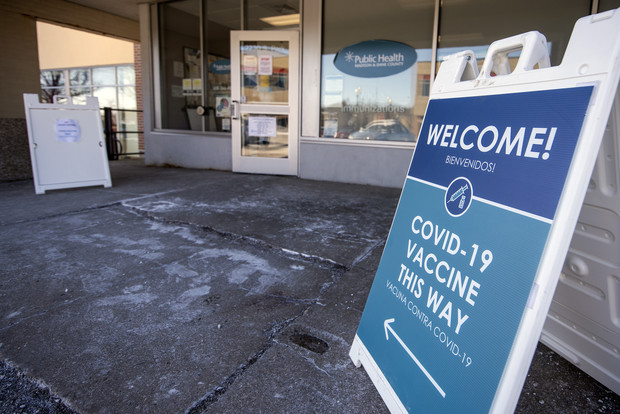Mayo Clinic Docs Warn Of Omicron Subvariant
CDC estimates subvariant is most common in U.S. Doctors ask for continued vigilance.

A sign outside of a Public Health Madison & Dane County clinic Monday, Jan. 10, 2022, in Madison, Wis. Angela Major/WPR
Mayo Clinic doctors said Wednesday in a virtual news conference that a new strain of the virus that causes COVID-19 probably won’t result in as big a wave of cases as the original omicron variant, but they say communities still need to stay alert.
Speaking to journalists during the briefing, the doctors said BA.2, a subset of omicron, has a higher transmission rate than prior variants. Dr. Jack O’Horo, an infectious disease specialist at Mayo Clinic, said vaccines and masks are still important.
O’Horo said the BA.2 strain is starting to increase virus activity.
“Whether that ends up being a larger increase in cases or a smaller one, I’d say still is waiting to be seen,” O’Horo said. “It certainly doesn’t look like it’s going to be anything on the order of what we’ve seen with prior spikes.”
Dr. Matthew Binnicker, director of Mayo Clinic’s Clinical Virology Laboratory, said BA.2 has some specific mutations that could allow it to more efficiently evade immunity.
“We do think that infection with the original omicron strain is going to elicit some immunity that helps to protect an individual from reinfection, although it’s not impossible for an individual to be reinfected,” Binnicker said.
Binnicker said at-home antigen tests should still be able to pick up the subvariant, though he noted it can take longer for at-home tests to detect positive results compared to PCR tests.
“If you’ve been exposed or if you have symptoms and you test negative, it doesn’t necessarily mean you’re in the clear with regards to COVID infection,” Binnicker said. “You may need to perform a follow-up test in a few days.”
BA.2 has been nicknamed a “stealth” variant, possibly in part because it’s more difficult to track. But Binnicker pushed back against that idea.
“Stealth variant really implies that it’s going undetected, that we’re missing it,” Binnicker said. “It was kind of, I think, wrongly given that name.”
The Centers for Disease Control and Prevention estimate BA.2 has become the most common strain of coronavirus in the U.S.
Looking ahead
The doctors also said the future of the COVID-19 pandemic is going to depend on local trends in cases rather than national waves.
“As we enter into an endemic phase of COVID, that’s not a one-way door,” O’Horo said. “That does mean that there is going to be some locally predominant patterns where there can be higher or lower activity.”
“I think it’s got to, in the future, become a very geographically specific type of approach, because we’re not going to see surges or increases in cases across the entire country,” Binnicker said.
Binnicker said prior infection and vaccination rates in communities will also determine which areas are most vulnerable to spikes. Binnicker noted vaccination provides a more robust immune response to COVID-19 than natural infection.
“It’s a spectrum of that immunity and the vaccine is a very safe way to deliver a standardized immune response,” Binnicker said.
O’Horo said while there’s still uncertainty around long COVID, how to approach it and what the risk factors are, he mentioned a study suggesting vaccination could reduce the risk of getting it.
O’Horo encouraged groups eligible for a second booster to get it.
“I don’t think you gain any significant advantage by waiting,” O’Horo said. “There still is a fair amount of community circulation of COVID, even though it is at a nadir right now.”
The Wisconsin Department of Health said the state is averaging around 360 new COVID cases a day. That’s down from an average of almost 19,000 cases a day in mid-January.
Listen to the WPR report here.
Mayo Clinic doctors: Communities need to be vigilant as subvariant becomes more prevalent in Wisconsin was originally published by Wisconsin Public Radio.
More about the Coronavirus Pandemic
- Governors Tony Evers, JB Pritzker, Tim Walz, and Gretchen Whitmer Issue a Joint Statement Concerning Reports that Donald Trump Gave Russian Dictator Putin American COVID-19 Supplies - Gov. Tony Evers - Oct 11th, 2024
- MHD Release: Milwaukee Health Department Launches COVID-19 Wastewater Testing Dashboard - City of Milwaukee Health Department - Jan 23rd, 2024
- Milwaukee County Announces New Policies Related to COVID-19 Pandemic - David Crowley - May 9th, 2023
- DHS Details End of Emergency COVID-19 Response - Wisconsin Department of Health Services - Apr 26th, 2023
- Milwaukee Health Department Announces Upcoming Changes to COVID-19 Services - City of Milwaukee Health Department - Mar 17th, 2023
- Fitzgerald Applauds Passage of COVID-19 Origin Act - U.S. Rep. Scott Fitzgerald - Mar 10th, 2023
- DHS Expands Free COVID-19 Testing Program - Wisconsin Department of Health Services - Feb 10th, 2023
- MKE County: COVID-19 Hospitalizations Rising - Graham Kilmer - Jan 16th, 2023
- Not Enough Getting Bivalent Booster Shots, State Health Officials Warn - Gaby Vinick - Dec 26th, 2022
- Nearly All Wisconsinites Age 6 Months and Older Now Eligible for Updated COVID-19 Vaccine - Wisconsin Department of Health Services - Dec 15th, 2022
Read more about Coronavirus Pandemic here

















